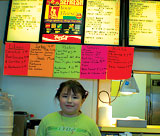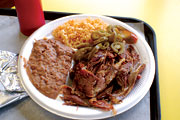
Flavor: Straight off the Mexican street
Ambiance: Cut-rate fast-food joint
Americans are suckers for eating out. According to some studies, as many as two out of every three meals consumed in this country are prepared by professionals (meaning the meal eaten at home likely comes from a Styrofoam container crammed with last night’s leftovers.)

photos by Jodi Ford
|
Economists argue the high cost of groceries is driving Americans to restaurants, which suggests the sad spectacle of diners crying into their creamed spinach, nursing memories of the days when they could afford to buy their own bunches of leafy greens. But anyone who’s eaten out lately knows it’s the rare restaurant that fills its seats with folks who wish they were somewhere else: Americans adore the restaurant experience, from its splashy menus to its bottomless soft drinks.
Not to get too sentimental about it, but restaurants exemplify the democracy our founding fathers had in mind when they heaved Darjeeling tea into Boston Harbor. Restaurants are places where anyone with enough cash in their billfold is entitled to the same indulgent service and well-prepared (or not-so-well-prepared, depending on who’s in the kitchen) food, at the same price. This policy is solemnly observed at countless middlebrow places, which have built their businesses on treating all customers in the manner to which they imagine the rich have become accustomed.
But this culinary commitment to equality is routinely flouted at the high and low ends of the food-service spectrum, with restaurateurs making a point of cultivating an insiderism that would set George Washington’s wooden teeth on edge. The multistarred establishments in the restaurant galaxy are, of course, notoriously cliquish, shunting newcomers to undesirable tables, reserving off-the-list wines for regulars and sometimes even hiding their entrances behind unmarked doors. Much to the chagrin of foodies, affordable lunch joints can be just as coy, refusing to yield their delights to anyone not in the know.
Restaurant Herrera is one of those places. The converted greasy spoon in Candler still honors the menu that’s apparently hung above its counter since before the current owners took over in 2003. If you have a hankering for a gyro or a chuckwagon burger, the women working the line will gladly throw one on the grill. But the real draw here is the array of down-home Mexican lunch plates, including the barbacoa, a slow-cooked meat dish that was perfected by ranch hands in northern Mexico and slipped over the Texas border into the United States.
Like cold weather and liberalism, the meaning of the word barbacoa varies depending on where you’re standing. In the Yucatan, barbacoa diners prime themselves for pork. In Central Mexico, lamb is the featured meat. And in Northern Mexico, most preparations call for goat.
Recipes for Texas-style barbacoa usually start with some variation on the phrase “Take one 25-pound cow’s head, cleaned and skinned.” Herrera’s spartan decor does include a hulking wall-mounted cow’s skull, which seemed a good indication of the kitchen’s allegiance to Texan traditions. But one taste of the greasy chunked meat — it’s sold in 1/2-pound and 1-pound portions, with a side of warmed tortillas — revealed no part of any cow was sacrificed for this meal. It was obviously rooted elsewhere in the barnyard.
The cashier, the only staff member not obviously of Hispanic descent, assured us the barbacoa — which she insisted on pronouncing as “barbecue-ahh” — was made from goat meat. She was quickly corrected by another employee, who felt certain the cook used sheep (an assertion verified by a second sampling). But both women were sure we’d been served a melange of parts.
With a barbacoa banner proudly slapped over the fried-chicken sign in Herrera’s parking lot, this is what goes unadvertised: If you want a head on your platter — or any other particular cut of meat — you have to call in your request in advance. Now you know.
(I wish I knew the secret for obtaining one of the sugary concoctions the cashier tentatively chewed during my visit. Apparently prepared for her by one of the cooks, she loudly likened it to a water chestnut, becoming alternately fascinated and repulsed by its flavor. After proclaiming her affection for the treat, she finally decided to spit it out.)
Other insider info at Herrera includes the whereabouts of the pico de gallo, the restaurant’s maddeningly elusive signature sauce. Turns out it only makes an appearance on the weekends. That leaves weekday diners — and there are many of them — with the house-made salsa, an alternative so good that even serious pico de gallo devotees are likely to use the red plastic squeeze bottle for a few extra squirts. The cilantro-speckled sauce, while not hot, has a robust tomato flavor that perfectly complements the available meats.
In addition to barbacoa, Herrera offers chicken and an admirable rendition of carnitas that outshone our hodgepodge of slow-cooked mutton. The seasoned pork was perfectly fried to a supple tenderness that crisped at the edges, managing to fall on the right side of the line between fatty and greasy. Carnitas is not a dieter’s dish: Even neutered versions offered by Americanized restaurants, which tend to shy away from using lard, have four-digit calorie counts. The dish is a celebration of pork fat, and Herrera has its party hat on.
Herrera knows how to put a pig to good use (its 2007 souvenir calendar features a smiling Porky Pig submerged waist-deep in a vat of boiling oil). The restaurant seems to make liberal use of lard in its tamales, which are, perhaps, the best reason to visit. The masa has a near-perfect consistency, neither too spongy nor too crumbly, and is applied in perfect proportion to the filling of green olive-flecked chicken. Paired with a tall to-go cup of horchata served from the giant translucent tub perched behind the counter, the husk-wrapped snacks make a fine meal. I haven’t yet sampled enough Buncombe County tamales to crown it best in the region, but I look forward to returning for comparative purposes. Perhaps one day I’ll be the insider.



Before you comment
The comments section is here to provide a platform for civil dialogue on the issues we face together as a local community. Xpress is committed to offering this platform for all voices, but when the tone of the discussion gets nasty or strays off topic, we believe many people choose not to participate. Xpress editors are determined to moderate comments to ensure a constructive interchange is maintained. All comments judged not to be in keeping with the spirit of civil discourse will be removed and repeat violators will be banned. See here for our terms of service. Thank you for being part of this effort to promote respectful discussion.